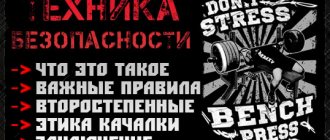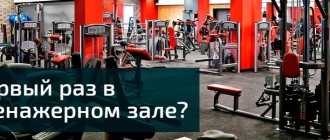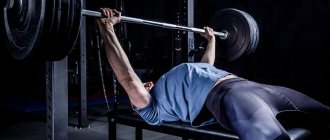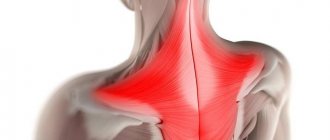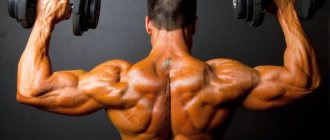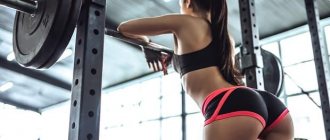December 15, 2016 Admin Home page » Tips and recommendations
Find out how to increase your punching power in the gym and impress everyone with speed-strength training and endurance.
You've probably heard more than once that training in the gym and boxing gym cannot be combined, muscle mass interferes with the development of speed, mobility is lost, and the ability to evade an opponent's blows decreases. However, if you approach this matter wisely, then training in the house of the “jocks” will not be harmful, but for the good, i.e. Strength training for a boxer is not a whim, but a necessity.
Lack of strength will not allow you to develop decent speed, sharpness, power and density of punches. To achieve this you need to correctly develop the muscle areas that are involved in the boxing process, namely:
- deltoid muscles
- arm extensor muscles
- chest muscles
- back muscles
- leg muscles
- lateral abdominal muscles
Let's look at a set of exercises to develop the strength of each of them.
Subscribe to groups on social networks (VKontakte, Odnoklassniki, Facebook, Twitter, Yandex Zen), it’s very easy to find us, just write Bomb body in the search for the desired group!
Classification of physical qualities of a boxer
The physical qualities of a boxer are divided into several types:
- Power;
- Agility;
- Endurance;
- Speed (response);
- Maintaining balance.
An athlete's strength is the ability to overcome external resistance or influence the environment through muscle activation. Muscular strength is an important quality of a boxer, which determines the power of the blow and work in the clinch. Special importance is given to the so-called “explosive” force, i.e. the ability to exert maximum physical impact on an opponent in a short period of time.
Agility is the ability of a boxer to quickly and accurately carry out a list of actions depending on the situation. The basis for this quality is the mobility of motor skills. A deft boxer can wisely choose the time and place of striking, escaping pressure, and entering a clinch.
Endurance refers to the ability to perform required movements for a long time. This quality is indicated by activity from the beginning to the end of the fight. As the battle progresses, it steadily decreases, as physical capabilities gradually dry up. The key to success in a boxing match is to prolong the effectiveness of movements, for which endurance is trained.
Speed and reaction - the ability to instantly or in a short period of time carry out actions in accordance with the tasks being solved during the battle. The qualities presented are determined by simple actions practiced in training. With the development of speed and reaction, the boxer responds with pre-programmed movements, which are performed as a response to a specific activity of the opponent (strike, entry into a clinch, attempt to drive into the corner of the ring, etc.).
Maintaining balance is the ability to distribute body weight, i.e. move your center of gravity while remaining on your feet. Regardless of the distance of the fight or the impact on the opponent, it is important to be able to properly balance your own weight. This quality also allows you to avoid falling under enemy attacks.
Working on technology
If you want to train at home in order to become like the king of the ring in appearance, to develop muscles like a boxing champion, and not a bodybuilding champion, we do not recommend doing only strength exercises for boxers, neglecting technique. Follow the entire fighter's training program, strengthening your body and spirit.
The first and subsequent boxing training sessions certainly include practicing:
- correct strikes;
- various combinations;
- defensive movements - escapes, ducks, dives, blocks.
The five punches at the heart of boxing:
- Jab - a straight punch with the front hand. The elbow is fully extended, the clenched fist is turned palm down.
- Cross - a direct strike with the far hand.
- Hook - a side blow with a hand bent at the elbow. Applicable only at close or medium range.
- Swing - a side strike with a straightened arm in long-range combat.
- An uppercut is an upward blow in close combat.
Best punch combinations:
- double strike - left jab, right cross (hereinafter - vice versa for left-handers);
- two left jabs, right cross;
- left jab, right swing;
- Left uppercut, right hook;
- Right uppercut, left hook.
Start by practicing individual strikes, then add combinations to them, but not earlier than the third week of classes.
An approximate program of technique exercises without a sparring partner at the initial stage of training:
- jabs from a front stance (FS) - feet shoulder-width apart, knees slightly bent, fists near the chest;
- slopes from one's stance (SS) - the weaker leg and arm are brought forward, the second protects the jaw, the strong arm is at chest level;
- crosses from SS;
- SS dives;
- hooks from FS;
- blocks from SS;
- uppercuts from FS.
Do each exercise one round lasting 3 minutes (if it’s hard - 2 minutes).
Having mastered these basics of technique, continue to train the correct movements and reactions while mastering movements around the ring (or other battlefield).
Fighting excess weight
Most professional boxers are familiar with problems with excess weight. In order to bring your body weight back to normal, especially before the control weigh-in, there are a huge number of exercises. We will list the most common and available in any gym:
- Practicing blows on a punching bag (bag) - maximum impact is provided for 3 minutes with a minute break between approaches (depending on endurance, 3 or 5 such “rounds” are selected);
- Jumping rope - 3 sets of 10-15 minutes with a break of 5-7 minutes. This exercise is basic for burning weight, since up to 120 calories are consumed in 10 minutes of intense jumping;
- Running – uses a slow pace for long distances (from 3 km). With the help of this exercise, metabolism is accelerated, the cardiovascular system is strengthened, and stress is relieved.
Losing excess weight is impossible without a proper nutrition program. It is recommended to exclude fatty foods, sugar, and fast food from the diet. On average, a boxer spends 3-4 thousand calories per day during intense training. To “dry” you need to consume 300-400 calories less than the energy consumed.
General recommendations
Training with free weights lasts no more than 1 hour. It is during this period of time that the body is most efficient at producing testosterone. It is also worth remembering about proper nutrition. Include complex carbohydrates in your diet, try to drink at least 1.5 liters of water per day, eat small meals, but often (up to 7 times a day), do not forget about protein, you can find it in meat, fish, eggs.
Active muscle recovery is promoted not only by healthy sleep, but also by a sauna. Thanks to periodic visits to the bathhouse, you will maintain the elasticity of your muscles and additionally cleanse your body of toxins (not only water, but also toxins come out with sweat). In the sauna, the main thing is not to overexert yourself and you should visit it only for pleasure. Excessive temperature stress can have the opposite effect. So at the first sign of not relaxation, but fatigue, it is better to leave the steam room and go to the relaxation room. Visiting the sauna immediately after training is not recommended; it is better to set aside a separate day, free from sports training.
Cardio
Cardio training is carried out to strengthen the cardiovascular system, which in turn helps to develop endurance. During aerobic exercise, the heart muscle functions more intensely, saturating the blood with oxygen and nutrients. Popular exercises from this series are:
- Jumping;
- Rear heel strikes;
- Shadowboxing (4 rounds, 2 minutes each).
Jumping is performed only after preliminary warm-up. The feet are shoulder-width apart and the toes are slightly pointed to the side. A squat is done, while the socks do not come off the floor, after which the legs are sharply straightened and lifted off the floor as much as possible. For a high jump, add an arm swing. Watch your back: it should be as straight as possible while performing the exercise.
Rear heel strikes are performed from a standing position. The feet are shoulder-width apart, the right knee is initially bent, and the foot is brought to the buttock with the aim of hitting it. Next, the leg is straightened and similar movements are carried out with the second leg. To increase your heart rate, alternate legs as quickly as possible.
Shadowboxing is training boxing moves with an imaginary opponent. To prepare for a real fight, dodges, strikes, and movements are practiced. The main condition is continuity of movement, which helps improve endurance. Professional athletes often vary the rhythm during such training.
Tyson as an example
Mike Tyson (“Iron Mike”) is rightfully considered an excellent example of speed, punching power and physical fitness. Surely this effect was achieved thanks to the right approach to training. In his approach, he did not neglect any wrestling tasks (neck warm-up on a bridge), or powerlifting tasks (barbell press), or athletics tasks (long-distance cross-country).
You should also not neglect the usual horizontal bar and parallel bars. In order to improve your skills, it is not at all necessary to start immediately with a barbell, an athletic belt and a wrestling tights. In one training day, Iron Mike could perform up to 800 push-ups and up to 500 simple push-ups on the parallel bars. And now you just have to imagine how it was possible to escape from such a machine! I once heard that Mike specifically tried to arrange fights during the full moon because... his level of aggression at this time was at its very limit.
Endurance
In the development of endurance, a huge role is played by running, jumping rope, working with a punching bag, and race walking. It becomes the base without which preparation for battle is impossible. Among other relevant exercises to improve endurance, we note:
- Swimming;
- Outdoor games;
- "Quick hands" last 30 seconds;
- Work on the feet or with a sparring partner.
Endurance improves when swimming, both indoors and in open water. A leisurely pace is optimal, 20-30 minutes, 3-4 approaches. The break between approaches is 10-15 minutes. Outdoor games (football, basketball, handball, etc.) contribute to the formation and improvement of a whole group of physical qualities, including endurance.
Fast hands is an exercise that involves maximum physical involvement in the last 30 seconds of an impromptu round. After the sound signal, fast and direct blows are thrown. They do not have to be powerful or sweeping, but are carried out continuously. You need to aim at eye level, at the same time you can lower or raise your feet, which will significantly increase arm endurance and overall cardio. When performing strikes, do not forget to breathe.
Training with a sparring partner is carried out at a variable pace. Classes on technical and tactical skills are being practiced. Actions are as close as possible to those expected from a real opponent.
Impact force development
Impact force is determined by two factors: striking technique and muscle condition. The power of the direct blow is directed from the triceps. The change in impact also activates other muscle groups.
When performing a hook, the triceps and pectoral muscles are usually used. With an uppercut, they are joined by: biceps, lower back and back muscles.
Also, the power comes from the legs, and then the arms come in.
Rotational actions of the body are also required. This way the center of gravity is correctly distributed and the mass moves from foot to foot. The blow is carried out by the entire mass.
How should a boxer swing for punching power? This requires a varied training process. These include push-ups with mandatory clapping and punching bag work. The training is distributed in such a way that both muscles and striking dynamics are developed.
Sufficient training with the bar helps with throwing your arms out. This increases the sharpness of the blow.
You need to practice on the uneven bars and horizontal bar. Push-ups and pull-ups are performed at a high pace.
Shadow boxing required. In them, hands are thrown out quickly; strong blows are not needed. The main thing is speed and sharpness.
On the pear, visually mark areas for attacks. Hit them as harshly as possible.
These are the main aspects in the question of how to pump up a boxer in order to improve his striking qualities. Experts also recommend doing as many push-ups as possible, especially after training.
How to pump up a Thai boxer? The principles are similar here. You should not overload your muscles. A rocking chair is enough for 2-3 per week. For example: Tuesday – Thursday + Saturday. Sunday is rest. The remaining days are Muay Thai.
Both in boxing and in Muay Thai, the legs are of great importance. More about their development below.
Power training
In boxing, you cannot win a fight without a burst of activity and forceful action, so athletes pay special attention to building muscle mass. The main goal of training with iron is to increase strength, which can later be converted into power. By combining strength and endurance, a boxer has a greater chance of ultimate success in a fight. Popular strength training workouts include:
- Explosive style bench press – 5-7 reps, 5 sets, 1-2 minute break between sets;
- Weighted parallel bar push-ups (weight is selected depending on body weight) – 8-10 repetitions, 3-5 sets, break between sets 3-4 minutes;
- Bench press on an inclined plane of a barbell or dumbbells – 5-7 repetitions, 5 approaches, a break of 1-2 minutes between approaches;
- Middle delt fly - 4-6 repetitions, 3-5 sets, break between sets 2-3 minutes.
It is recommended to supplement strength training with a squat with a barbell (7-10 repetitions, 4-5 approaches) or a leg press on a special machine (8-12 repetitions, 4-5 approaches). You can complete the complex with sets of upper and lower abs (10-15 times, 3-5 approaches) with a break between sets of 1 minute. At the end of strength training, the boxer must perform stretching exercises on the muscles being loaded. This helps them relax and speed up recovery.
Reflections
Regarding the issue of alignment and scheduling, there are differing opinions. Some people believe that lifting weights the day before a boxing workout is unwise. This will cause the muscles to work ineffectively. And it’s better to install the exercise machine the next day after specialized classes.
The latter do not see any dilemma in this and are ready to fully train in both gyms.
Still others believe that any strength exercises with iron only have negative consequences. But they can be removed with 2-3 rounds of shadow boxing and muscle stretching.
Any position is rational. And for this reason, you should test different options and schedules and find the optimal mode for yourself.
Below are two versions of the lesson with step-by-step instructions. Today they are used by many boxers.
Strengthening exercises for fists and joints
There are two polar opinions in the world of boxing. Some believe that when practicing punches on a punching bag, the hands and fists become stronger on the outside. Some experts are of the opinion (and scientifically substantiate their point of view) that a boxer should strengthen these parts of the body “from the inside.” The following set of exercises is suitable for this:
- We take a lying position, lean on our fists, and place them so that the main impact falls on the impact zone of the fist, we pump up our knuckles and hands as if “rolling” on our fists;
- While lying down, we perform push-ups on the fingers: initially we use five fingers, as the hands and knuckles become stronger - three;
- We take the bar from the barbell with a narrow grip, sit on the bench, place our hands so that our palms with the bar are suspended, and perform translational movements of the bar up and down, using only our wrists.
Thus, physical training for a boxer is a set of exercises for developing the required qualities. It should be aimed at developing and improving those characteristics that are less “pumped” in the athlete. Eliminating weaknesses along with achieving “strong” characteristics is the key to success in battle.
Basic stages of boxer training
Training an amateur boxer, regardless of the place of training - in the gym or at home, includes five stages:
- warm-up;
- technical training with practicing movements around the ring;
- practicing punches on the punching bag, paws, working in sparring;
- exercises for muscle development;
- final part.
Warm-up is mandatory preparation for heavy physical exertion of muscles and ligaments to prevent muscle pain and injuries. It includes a sequence of light gymnastic exercises that engage all muscle groups - from the neck to the ankles.
In a gym or large room, some of the movements can be performed by jogging in a circle (running with head turns, swinging arms, raising knees).
At the second stage:
- elements of combat are mastered, then improved and brought to automatism - strikes, dives, dodging, moving around the ring with steps and short jumps;
- development of speed of movement, reaction, dexterity, development of excellent coordination;
- psychological preparation for work in the ring.
Sparring is designed to train technique in conditions “close to combat.” Paw work teaches you to strike hard at a “moving target.” The pear makes it possible to bring the very force of blows to the maximum.
The fourth stage - pumping up muscles - is as important as all the previous ones. Strength training for fighters differs from that of bodybuilders, but a boxer needs to train because:
- without powerful triceps and shoulder girdle there are no strong blows;
- strong abdominal muscles are needed for endurance and the ability to withstand blows to the body;
- when pumping your abs, you need to put a load on the long back muscles so as not to damage the spine;
- Strong legs and glutes are required to move around the ring with endurance and speed.
You should complete your workout by walking slowly, shaking your arms in a relaxed manner to relieve tension from tired muscles.
Basic exercises for training a boxer
We must not forget about the eight most useful movements that can be performed as a set of exercises for a boxer (remembering the warm-up). They develop well the qualities needed in boxing.
Run
Running is a key element in the training of healthy lifestyle fans, but it is also included in boxing exercises, since running training strengthens the body, increasing endurance, leg strength, strengthening the heart, blood vessels and ligaments, and developing breathing.
If your physical characteristics leave much to be desired, before becoming a boxer at home, devote 3-4 months to running. We advise you to start with jogging (2-3 kilometers), then add sprinting to your training program - running 60 and 100 meters.
One arm burpee
This exercise is a very effective technique for developing the muscles involved in boxing.
If at first you don’t succeed in it, start training without burpees, and add it to your training program after increasing your training.
Lying jumping
Rules for performing this element of strength training:
- starting position - emphasis, lying on your fists;
- pull your right leg towards your hand with a jump, return to IP;
- do the same with your left foot;
- the exercise continues until the last 2-3 repetitions are difficult.
Perform at least 2 approaches, over time increase their number to 3-4.
Timed push-ups
This is a universal boxing exercise. If you do push-ups for a while, making each movement with your arms as quickly as possible, your explosive power will quickly increase.
It is useful to alternate different execution techniques. For example, if you place your hands narrower, the load on the triceps will increase, and wider - on the chest muscles. If you have enough strength, do push-ups on one hand - first with your left, then with your right.
Fold with one leg alternating
An element of speed-strength training for a boxer, useful for simultaneously loading the core muscles and all the abdominal muscles. It is highly recommended for inclusion in independent training programs.
Twists diagonally
Good load on the oblique abdominal muscles. Included in the training plan of the novice boxing enthusiast, together with the crease, they provide maximum abdominal power.
Jumping rope
They guarantee a good cardio load, strengthening not only the legs, but also the heart. Mandatory when practicing boxing at home.
Note that many boxers prefer to alternate jumping ropes on each leg instead of both.
Gun
Pistol squats are called single-leg squats, which provide excellent load to the leg muscles. This is an excellent exercise for those learning boxing at home.


